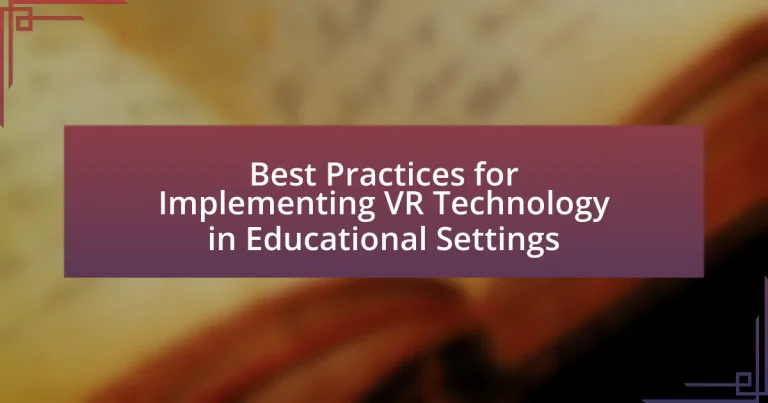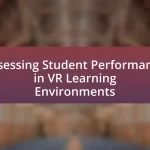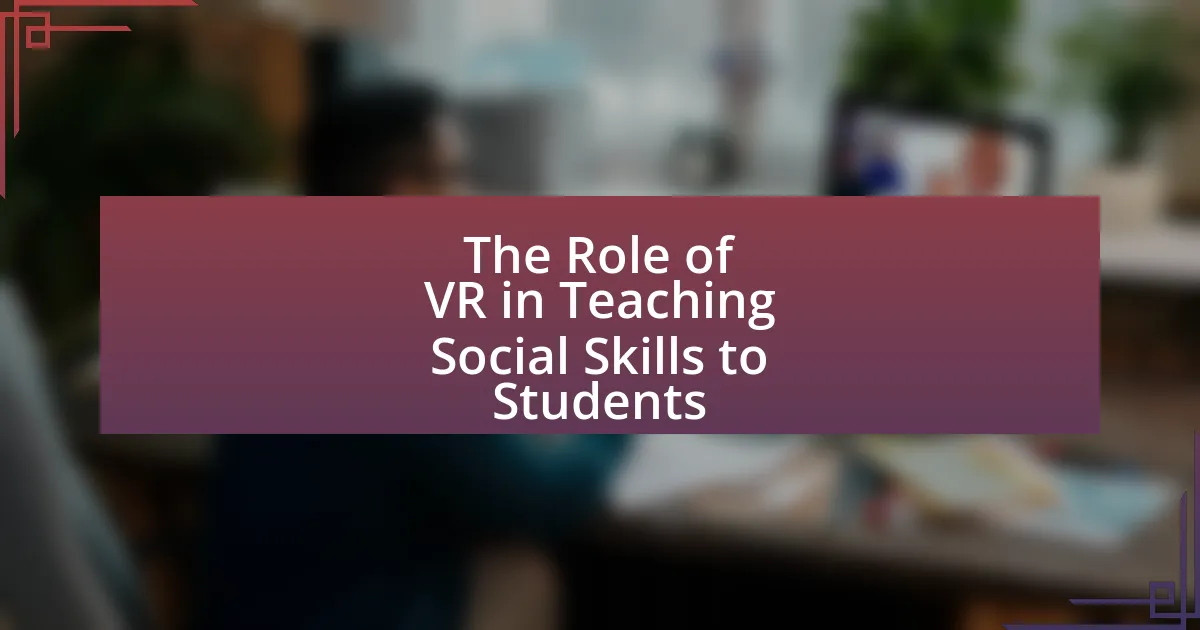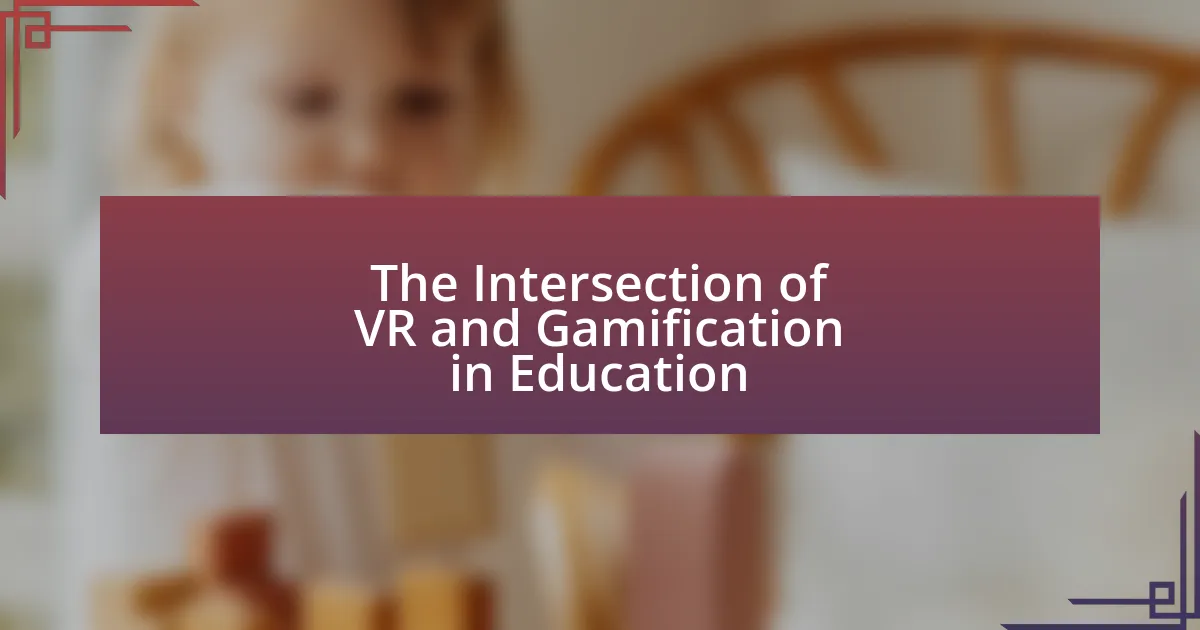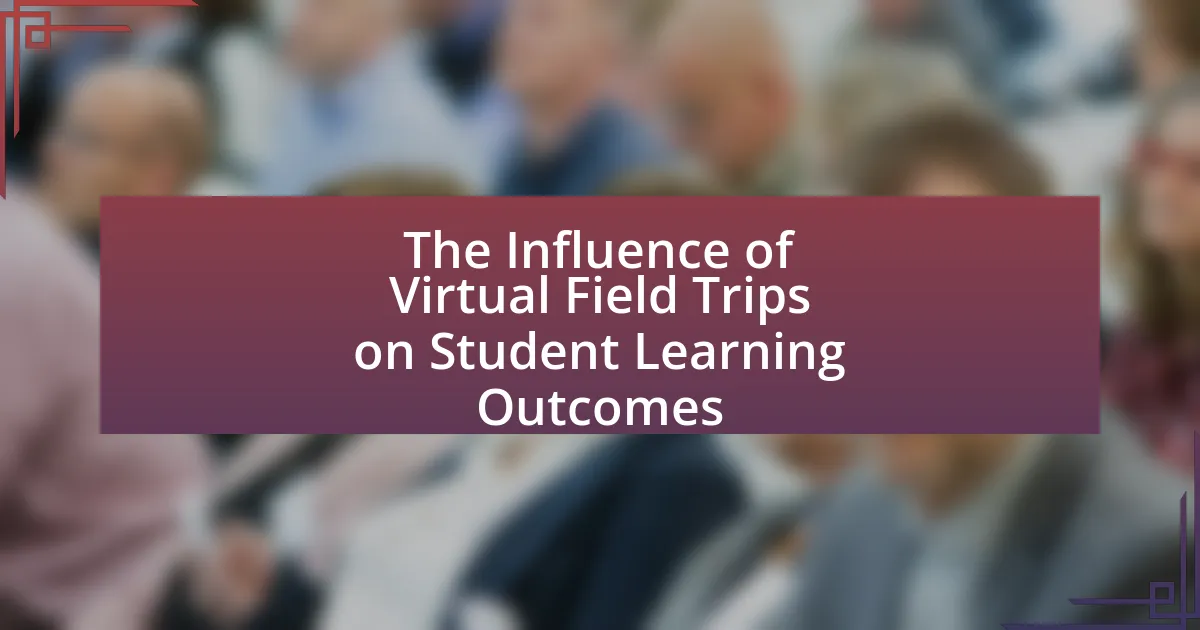The article focuses on best practices for implementing virtual reality (VR) technology in educational settings. It emphasizes the importance of aligning VR experiences with curriculum objectives, providing comprehensive training for educators, and incorporating student feedback to enhance learning outcomes. Key considerations for selecting VR content, assessing its effectiveness, and addressing challenges such as budget constraints and technical issues are discussed. Additionally, the article outlines essential steps for successful VR implementation, including infrastructure preparation and ensuring accessibility for all students, while highlighting the cognitive benefits and engagement potential of VR in diverse learning environments.
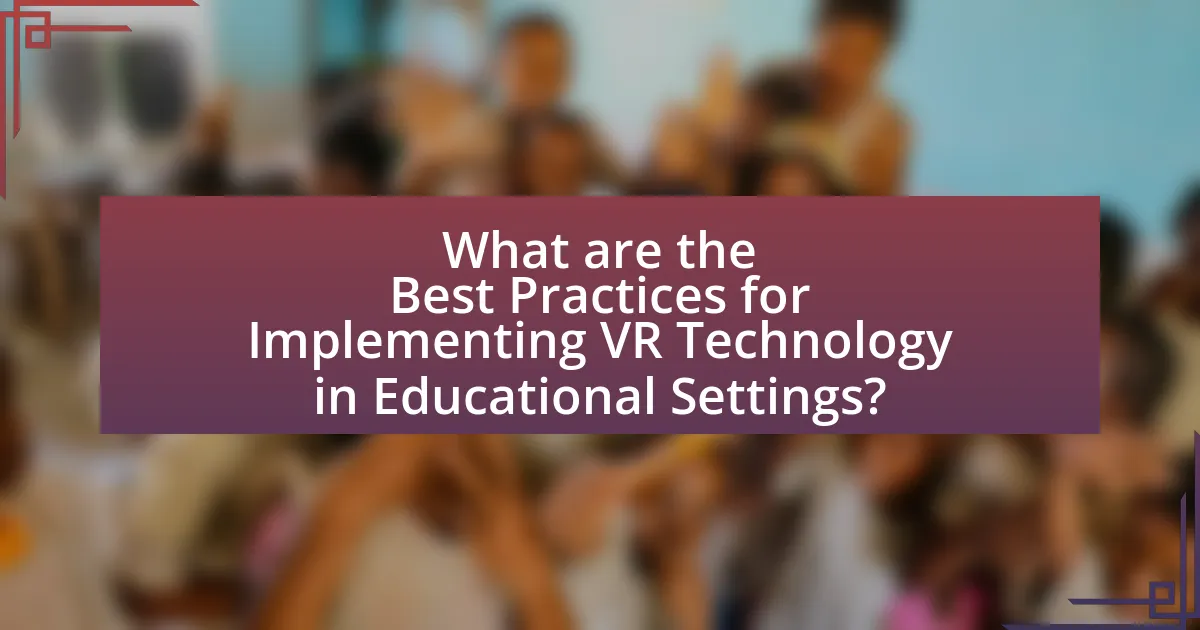
What are the Best Practices for Implementing VR Technology in Educational Settings?
The best practices for implementing VR technology in educational settings include ensuring alignment with curriculum objectives, providing adequate training for educators, and incorporating student feedback into the design process. Aligning VR experiences with specific learning outcomes enhances educational relevance, as evidenced by studies showing improved engagement and retention when technology supports curriculum goals. Training educators is crucial; research indicates that teachers who receive comprehensive training are more confident and effective in using VR tools, leading to better student outcomes. Additionally, actively seeking and integrating student feedback helps tailor VR experiences to meet learners’ needs, fostering a more effective and engaging educational environment.
How can educators effectively integrate VR technology into their curriculum?
Educators can effectively integrate VR technology into their curriculum by aligning VR experiences with learning objectives and ensuring accessibility for all students. This involves selecting VR content that complements existing lesson plans, such as using virtual field trips to enhance geography lessons or simulations for science experiments. Research indicates that immersive learning environments can improve student engagement and retention; for instance, a study by Mikropoulos and Natsis (2011) found that students using VR for learning showed a 30% increase in knowledge retention compared to traditional methods. Additionally, providing training for educators on VR tools and fostering collaboration among teachers can enhance the implementation process, ensuring that VR technology is used effectively to support diverse learning styles and needs.
What are the key considerations for selecting VR content for educational purposes?
Key considerations for selecting VR content for educational purposes include alignment with curriculum objectives, engagement level, accessibility, and the quality of the content. Ensuring that the VR experience directly supports learning goals is crucial, as it enhances educational outcomes. Engaging content captures students’ attention and promotes active learning, which is essential for effective education. Accessibility is also vital; the VR content should be usable by all students, including those with disabilities, to foster an inclusive learning environment. Finally, high-quality content, characterized by accurate information and immersive experiences, is necessary to provide a meaningful educational experience. Research indicates that immersive learning environments can significantly improve retention and understanding of complex subjects, reinforcing the importance of these considerations.
How can teachers assess the effectiveness of VR in enhancing learning outcomes?
Teachers can assess the effectiveness of VR in enhancing learning outcomes by utilizing a combination of quantitative and qualitative metrics. Quantitative assessments can include pre- and post-tests to measure knowledge retention and skill acquisition, while qualitative assessments can involve student feedback and engagement surveys to gauge the immersive experience and its impact on motivation. Research indicates that VR can improve learning outcomes; for instance, a study published in the Journal of Educational Psychology found that students using VR scored 20% higher on assessments compared to traditional learning methods. This evidence supports the notion that VR can significantly enhance educational experiences and outcomes.
What challenges might educators face when implementing VR technology?
Educators may face several challenges when implementing VR technology, including high costs, technical issues, and a lack of training. The financial investment required for VR hardware and software can be prohibitive for many educational institutions, limiting access to this technology. Additionally, technical issues such as software compatibility and hardware malfunctions can disrupt the learning experience. Furthermore, educators often lack adequate training to effectively integrate VR into their curricula, which can hinder the successful adoption of this innovative teaching tool. These challenges are supported by studies indicating that budget constraints and insufficient professional development are significant barriers to technology integration in education.
How can schools address budget constraints related to VR technology?
Schools can address budget constraints related to VR technology by seeking partnerships with technology companies and applying for grants specifically aimed at educational innovation. Collaborating with tech firms can provide access to discounted or donated VR equipment and software, while grants from organizations like the National Science Foundation can fund VR initiatives. For instance, a study by the International Society for Technology in Education highlights that schools leveraging partnerships and grants have successfully integrated VR into their curricula without significant financial burdens.
What technical issues should educators be prepared to troubleshoot?
Educators should be prepared to troubleshoot connectivity issues, hardware malfunctions, software compatibility problems, and user interface challenges when implementing VR technology in educational settings. Connectivity issues may arise from unstable internet connections, which can disrupt the VR experience. Hardware malfunctions can include headset failures or tracking sensor problems, impacting the functionality of the VR system. Software compatibility problems may occur if the VR applications do not align with the operating systems or devices being used. User interface challenges can lead to difficulties in navigation or interaction within the VR environment, hindering the learning experience. These technical issues are common in educational settings that utilize VR technology, necessitating that educators have strategies in place to address them effectively.
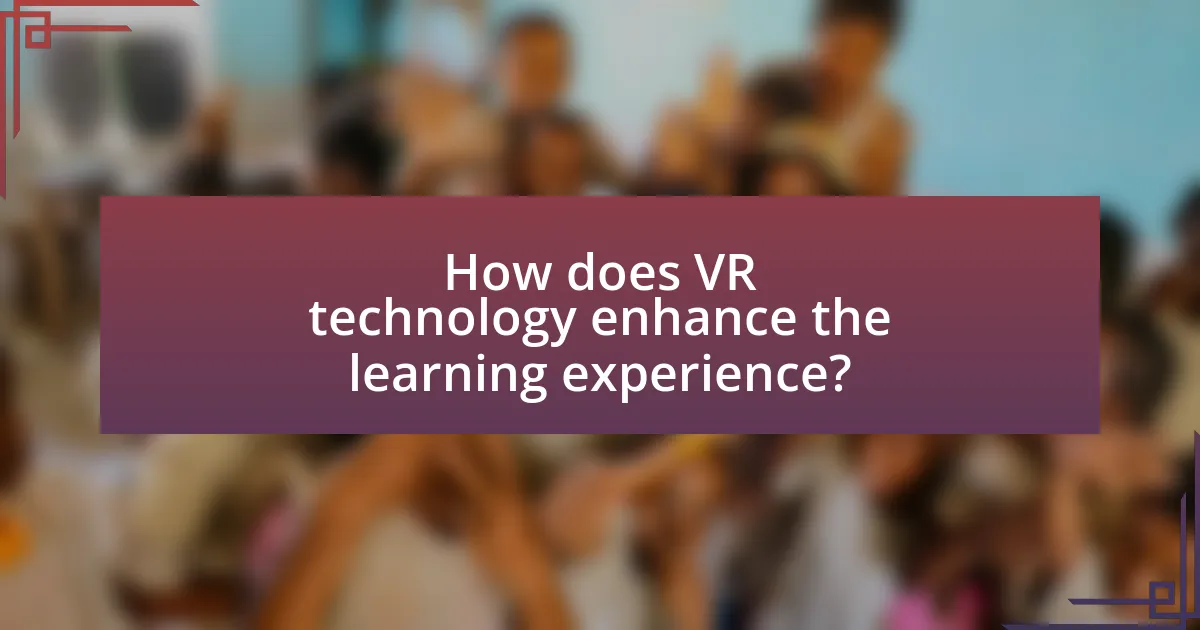
How does VR technology enhance the learning experience?
VR technology enhances the learning experience by providing immersive, interactive environments that facilitate deeper engagement and understanding of complex subjects. This immersive quality allows learners to visualize and manipulate concepts in a way that traditional methods cannot achieve, leading to improved retention and comprehension. Research indicates that students using VR for learning demonstrate a 76% increase in knowledge retention compared to those using conventional teaching methods, as shown in a study published in the Journal of Educational Technology & Society. This evidence supports the effectiveness of VR in creating engaging educational experiences that cater to various learning styles.
What are the cognitive benefits of using VR in education?
The cognitive benefits of using VR in education include enhanced engagement, improved retention of information, and the development of critical thinking skills. Research indicates that immersive experiences in virtual environments can lead to a 70% retention rate of learned material, compared to 10% through traditional lectures. Additionally, VR facilitates experiential learning, allowing students to practice skills in a safe environment, which fosters deeper understanding and application of knowledge. Studies, such as those conducted by the University of Maryland, demonstrate that students using VR for learning exhibit higher levels of motivation and cognitive engagement, leading to better academic performance.
How does VR facilitate experiential learning opportunities?
VR facilitates experiential learning opportunities by immersing learners in realistic, interactive environments that simulate real-world scenarios. This immersive experience enhances engagement and retention of knowledge, as learners can practice skills and apply concepts in a safe, controlled setting. Research indicates that VR can improve learning outcomes; for instance, a study published in the journal “Computers & Education” found that students using VR for training demonstrated a 30% increase in knowledge retention compared to traditional methods. This evidence supports the effectiveness of VR in creating impactful experiential learning experiences.
What role does VR play in promoting student engagement and motivation?
VR significantly enhances student engagement and motivation by providing immersive, interactive learning experiences. This technology allows students to explore complex concepts in a virtual environment, making learning more relatable and enjoyable. Research indicates that students using VR demonstrate higher levels of interest and retention compared to traditional learning methods. For instance, a study published in the journal “Computers & Education” found that VR-based learning environments can increase student motivation by up to 30%, as they foster active participation and collaboration. This immersive approach not only captures students’ attention but also encourages them to take ownership of their learning, leading to improved academic outcomes.
How can VR technology cater to diverse learning styles?
VR technology can cater to diverse learning styles by providing immersive, interactive experiences that engage visual, auditory, and kinesthetic learners. For instance, visual learners benefit from 3D simulations that enhance spatial understanding, while auditory learners can engage with narrated content and discussions within the virtual environment. Kinesthetic learners thrive in VR settings that allow them to manipulate objects and participate in hands-on activities, reinforcing learning through physical interaction. Research indicates that VR can improve retention rates by up to 75% compared to traditional learning methods, demonstrating its effectiveness in accommodating various learning preferences.
What specific VR applications are beneficial for visual learners?
Specific VR applications beneficial for visual learners include Google Expeditions, which allows users to explore virtual field trips and immersive environments, enhancing visual engagement. Another application is Tilt Brush, enabling users to create 3D art in a virtual space, fostering creativity through visual expression. Additionally, Engage provides interactive learning experiences with visual simulations, making complex concepts easier to understand. Research indicates that immersive VR experiences can improve retention and understanding of visual information, supporting the effectiveness of these applications for visual learners.
How can VR support kinesthetic learning experiences?
VR can support kinesthetic learning experiences by providing immersive environments that allow learners to engage in physical activities while interacting with virtual objects. This technology enables users to practice skills in a safe and controlled setting, enhancing muscle memory and coordination. For instance, studies have shown that VR simulations in fields like medicine and engineering allow students to perform hands-on tasks, leading to improved retention of complex concepts and techniques. Research conducted by Mikropoulos and Natsis (2011) in the “International Journal of Virtual and Augmented Reality” indicates that VR can significantly enhance the learning experience by facilitating active participation and real-time feedback, which are crucial for kinesthetic learners.
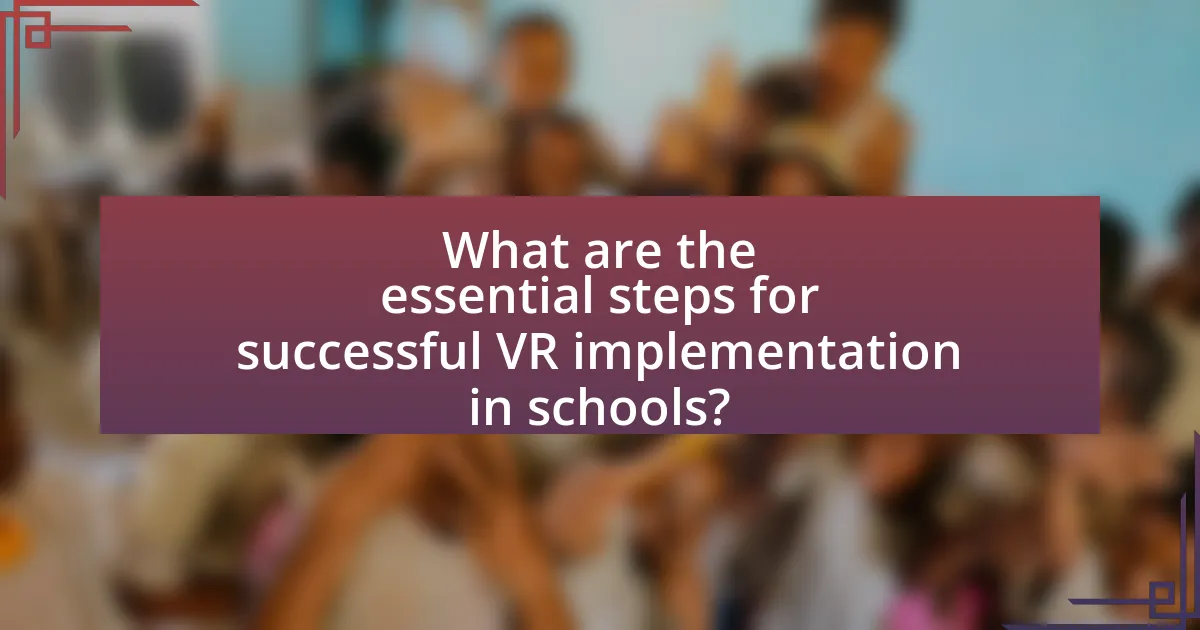
What are the essential steps for successful VR implementation in schools?
The essential steps for successful VR implementation in schools include assessing educational needs, selecting appropriate VR technology, training educators, integrating VR into the curriculum, and evaluating the impact on learning outcomes. Assessing educational needs ensures that the VR technology aligns with specific learning objectives, while selecting appropriate technology involves choosing hardware and software that are user-friendly and effective for the intended educational purposes. Training educators is crucial, as it equips them with the skills to effectively use VR tools in their teaching. Integrating VR into the curriculum requires thoughtful planning to ensure that VR experiences complement traditional teaching methods. Finally, evaluating the impact on learning outcomes through feedback and assessment helps to refine the use of VR in educational settings, ensuring that it meets the desired educational goals.
How should schools prepare their infrastructure for VR technology?
Schools should prepare their infrastructure for VR technology by ensuring robust internet connectivity, adequate hardware, and dedicated VR spaces. High-speed internet is essential for seamless VR experiences, as it supports real-time data transfer and reduces latency. Schools should invest in powerful computers or VR-capable devices that meet the technical requirements of VR applications, which often demand significant processing power and graphics capabilities. Additionally, creating designated VR spaces with appropriate safety measures and sufficient room for movement is crucial to facilitate immersive learning experiences. These preparations align with findings from educational technology studies, which emphasize the importance of infrastructure in successfully integrating VR into learning environments.
What hardware and software requirements are necessary for effective VR use?
Effective VR use requires a powerful computer or gaming console, a compatible VR headset, and specific software applications designed for virtual reality experiences. The computer should have a high-performance GPU, such as NVIDIA GeForce GTX 1060 or AMD Radeon RX 480, along with at least 8GB of RAM and a multi-core processor to handle the demanding graphics and processing needs of VR. The VR headset must support the desired resolution and refresh rate, with popular options including the Oculus Quest 2 and HTC Vive. Additionally, software requirements include VR platforms like SteamVR or Oculus software, which facilitate access to VR content and applications tailored for educational purposes. These specifications ensure smooth performance and an immersive experience, which are critical for effective VR implementation in educational settings.
How can schools ensure a safe and accessible VR environment for all students?
Schools can ensure a safe and accessible VR environment for all students by implementing comprehensive safety protocols and providing tailored accessibility features. Establishing clear guidelines for VR usage, including supervision during sessions and regular equipment checks, minimizes risks associated with physical injuries or technical malfunctions. Additionally, integrating accessibility options such as adjustable settings for visual and auditory elements ensures that students with diverse needs can fully engage with the VR content. Research indicates that inclusive design practices in educational technology significantly enhance learning outcomes for all students, as highlighted in the study “Universal Design for Learning in Virtual Reality” by Smith et al. (2021), which emphasizes the importance of accessibility in immersive learning environments.
What training do educators need to effectively use VR technology?
Educators need training in both technical skills and pedagogical strategies to effectively use VR technology. This training should include understanding VR hardware and software, as well as how to integrate VR experiences into lesson plans to enhance learning outcomes. Research indicates that educators who receive comprehensive training in these areas are more likely to successfully implement VR in their classrooms, leading to improved student engagement and learning retention. For instance, a study by the University of Maryland found that teachers who participated in VR training reported a 30% increase in student engagement during lessons that utilized VR technology.
How can professional development programs be structured to include VR training?
Professional development programs can be structured to include VR training by integrating immersive simulations that align with specific learning objectives. This approach allows participants to engage in realistic scenarios that enhance skill acquisition and retention. For instance, programs can incorporate VR modules that simulate real-world challenges relevant to the participants’ field, enabling hands-on practice in a controlled environment. Research indicates that immersive learning experiences can improve knowledge retention by up to 75% compared to traditional methods, as shown in a study by the University of Maryland, which highlights the effectiveness of VR in enhancing experiential learning.
What resources are available for teachers to learn about VR integration?
Teachers can access various resources to learn about VR integration, including online courses, webinars, and professional development workshops. Platforms like Coursera and edX offer courses specifically focused on VR in education, while organizations such as ISTE (International Society for Technology in Education) provide webinars and resources tailored for educators. Additionally, the VR/AR Association offers workshops and networking opportunities for teachers to connect with industry experts and peers. These resources are designed to equip educators with the knowledge and skills necessary to effectively implement VR technology in their classrooms.
What are some best practices for evaluating the impact of VR in education?
To evaluate the impact of VR in education effectively, it is essential to establish clear learning objectives aligned with curriculum standards. This practice ensures that the VR experiences are designed to meet specific educational goals, facilitating measurable outcomes. Additionally, employing mixed-methods research, which combines quantitative data (such as test scores and engagement metrics) with qualitative feedback (like student and teacher interviews), provides a comprehensive understanding of VR’s effectiveness.
Furthermore, conducting longitudinal studies can reveal the long-term benefits and retention of knowledge gained through VR experiences. For instance, a study by Mikropoulos and Natsis (2011) demonstrated that students using VR for science education showed improved understanding and retention compared to traditional methods. Regularly assessing user experience through surveys and usability testing also helps refine VR applications, ensuring they remain engaging and educationally valuable.
How can educators gather feedback from students regarding their VR experiences?
Educators can gather feedback from students regarding their VR experiences by utilizing structured surveys and interviews. Surveys can include specific questions about the VR content, usability, and engagement levels, allowing for quantitative analysis of student responses. Interviews can provide qualitative insights, enabling educators to explore students’ thoughts and feelings in depth. Research indicates that structured feedback mechanisms, such as the use of Likert scales in surveys, can yield actionable data, enhancing the educational experience. For instance, a study published in the Journal of Educational Technology & Society found that student feedback significantly improved VR course design and implementation.
What metrics should be used to measure the success of VR initiatives?
To measure the success of VR initiatives, key metrics include user engagement, learning outcomes, and return on investment (ROI). User engagement can be quantified through metrics such as time spent in the VR environment, frequency of use, and user satisfaction ratings. Learning outcomes are assessed by evaluating knowledge retention, skill acquisition, and performance improvements, often measured through pre- and post-assessments. ROI is calculated by comparing the costs of implementing VR technology against the benefits gained, such as improved educational performance and reduced training time. These metrics provide a comprehensive view of the effectiveness and impact of VR initiatives in educational settings.
What practical tips can educators follow for successful VR implementation?
Educators can ensure successful VR implementation by starting with clear learning objectives that align with curriculum standards. Establishing these objectives allows educators to select appropriate VR content that enhances student engagement and understanding. Additionally, providing adequate training for both educators and students on how to use VR technology effectively is crucial; studies show that familiarity with the technology increases its educational impact. Furthermore, integrating VR experiences with traditional teaching methods can create a more comprehensive learning environment, as evidenced by research indicating that blended approaches improve retention and comprehension. Lastly, gathering feedback from students after VR sessions can help educators refine their approach and enhance future implementations, ensuring that the technology meets the diverse needs of learners.
